Detailed Investigation of Cobalt-Rich Crusts in Complex Seamount Terrains Using the Haima ROV: Integrating Optical Imaging, Sampling, and Acoustic Methods
Abstract
1. Introduction
2. Materials and Methods
2.1. Survey Equipment
2.2. Detailed Survey Methods
2.3. Data Collection Process in Caiwei Guyot
3. Results
3.1. Optical Imaging: Spatial Distribution of Crusts
3.2. Sampling and Acoustic Measurements: Crust Thickness and Sample Component
4. Discussion
4.1. Analysis of Spatial Distribution and Thickness Characteristics of Crusts in Seamount Complex Terrain
4.2. Characteristics and Advantages of ROV-Based Fine-Scale Surveys in Complex Seamount Terrain
5. Conclusions
Author Contributions
Funding
Data Availability Statement
Conflicts of Interest
References
- Friedrich, G.; Schmitz-Wiechowski, A. Mineralogy and chemistry of a ferromanganese crust from a deep-sea hill, central Pacific, “Valdivia” cruise VA 132. Mar. Geol. 1980, 37, 71–90. [Google Scholar] [CrossRef]
- Aplin, A.C.; Cronan, D.S. Ferromanganese oxide deposits from the central Pacific Ocean, I. Encrustations from the Line Islands Archipelago. Geochim. Cosmochim. Acta 1985, 49, 427–436. [Google Scholar] [CrossRef]
- Halbach, P. Processes controlling the heavy metal distribution in Pacific ferromanganese nodules and crusts. Geol. Rundsch. 1986, 75, 235–247. [Google Scholar] [CrossRef]
- Hein, J.R.; Koschinsky, A.; Bau, M.; Manheim, F.T.; Kang, J.K.; Roberts, L. Cobalt-rich ferromanganese crusts in the Pacific. In Handbook of Marine Mineral Deposits; Cronan, D.S., Ed.; CRC Press: Boca Raton, FL, USA, 2000; pp. 239–279. [Google Scholar]
- Ma, W.; Chu, F.; Jin, X. Method approach of resource assessment and ore delineation for the cobalt-rich crust. Acta Oceanol. Sin. 2008, 29, 67–73. [Google Scholar]
- Okamoto, N.; Usui, A. Regional distribution of Co-rich ferromanganese crusts and evolution of the seamounts in the Northwestern Pacific. Mar. Georesour. Geotechnol. 2014, 32, 187–206. [Google Scholar] [CrossRef]
- Hein, J.R.; Mizell, K.; Koschinsky, A.; Conrad, T.A. Deep-ocean mineral deposits as a source of critical metals for high and green technology applications: Comparison with land-based resources. Ore Geol. Rev. 2013, 51, 1–14. [Google Scholar] [CrossRef]
- Hein, J.R.; Koschinsky, A. Deep-ocean ferromanganese crusts and nodules. Treatise Geochem. 2014, 13, 273–291. [Google Scholar]
- Jiao, D.; Jin, X.; Chu, F.; Hu, G.; Wang, Y. Formation conditions and control factors of thick Co-rich ferromanganese crusts. Miner. Deposits 2007, 26, 296–306. [Google Scholar]
- Zhang, F.; Zhang, W.; Ren, X.; Zhang, X.; Zhu, K. Resource estimation of Co-rich crusts of seamounts in the three oceans. Acta Oceanol. Sin. 2015, 37, 88–105. [Google Scholar]
- Halbach, P.E.; Jahn, A.; Cherkashov, G. Marine Co-rich ferromanganese crust deposits: Description and formation, occurrences and distribution, estimated worldwide resources. In Deep-Sea Mining; Sharma, R., Ed.; Springer: Cham, Switzerland, 2017; pp. 65–141. [Google Scholar]
- Usui, A.; Nishi, K.; Sato, H.; Nakasato, Y.; Thornton, B.; Kashiwabara, T.; Tokumaru, A.; Sakumaru, A.; Yamaoka, K.; Kato, S.; et al. The continuous growth of hydrogenetic ferromanganese crusts since 17 Myr ago on Takuyo-Daigo Seamount, NW Pacific, at water depths of 800–5500 m. Ore Geol. Rev. 2017, 87, 71–87. [Google Scholar] [CrossRef]
- Liu, Y.; He, G.; Yao, H.; Yang, Y.; Ren, J.; Guo, L.; Mei, Y. Global distribution characteristics of seafloor cobalt-rich encrustation resources. Miner. Deposits 2013, 32, 1275–1284. [Google Scholar]
- Riemann, F. Biological aspects of deep-sea manganese nodule formation. Oceanol. Acta 1983, 6, 303–311. [Google Scholar]
- Yamazaki, T.; Tsurusaki, K.; Chung, J.S. A gravity coring technique applied to cobalt-rich manganese deposits in the Pacific Ocean. Georesour. Geotechnol. 1996, 14, 315–334. [Google Scholar] [CrossRef]
- Anderson, J.T.; Holliday, D.V.; Kloser, R.; Dave, G.R.; Simard, Y.; Brown, C.J.; Chapman, R.; Coggan, R.; Kieser, R.; Michaels, W.L.; et al. Acoustic seabed classification of marine physical and biological landscapes. ICES Coop. Res. Rep. 2007, 286, 1–6. [Google Scholar]
- Usui, A.; Okamoto, T. Geophysical and geological exploration of cobalt-rich ferromanganese crusts: An attempt of small-scale mapping on a Micronesian seamount. Mar. Georesour. Geotechnol. 2010, 28, 192–206. [Google Scholar]
- Luo, W.; He, S. Application of rock dredge to cobalt-rich crust investigation. Mar. Geol. Front. 2017, 33, 66–70. [Google Scholar] [CrossRef]
- He, Q.; Yuan, B. A preliminary study on detecting the thickness of cobalt-rich crust in the ocean by acoustic wave. Min. Technol. 2003, 3, 93–95. [Google Scholar]
- Jin, X. The development of research in marine geophysics and acoustic technology for submarine exploration. Prog. Geophys. 2007, 22, 1243–1249. [Google Scholar]
- Anderson, J.T.; Van, H.D.; Kloser, R.; Reid, D.G.; Simard, Y. Acoustic seabed classification: Current practice and future directions. ICES J. Mar. Sci. 2008, 65, 1004–1011. [Google Scholar]
- Yu, Q.; He, G.; Yang, Y. Status quo and prospect in acoustic detection technology for submarine cobalt-rich crust exploration. Mar. Geol. Front. 2024, 40, 83–92. [Google Scholar]
- Yeo, I.A.; Howarth, S.A.; Spearman, J.; Cooper, A.; Crossouard, N.; Taylor, J.; Turnbull, M.; Murton, B.J. Distribution of and hydrographic controls on ferromanganese crusts: Tropic Seamount, Atlantic. Ore Geol. Rev. 2019, 114, 103131. [Google Scholar]
- Yang, Y.; He, G.; Liu, Y.; Ma, J.; Wei, Z.; Guo, B. Automated multi-scale classification of the terrain units of the Jiaxie Guyots and their mineral resource characteristics. Acta Oceanol. Sin. 2022, 41, 129–139. [Google Scholar] [CrossRef]
- Johnson, H.P.; Helferty, M. The geological interpretation of side-scan sonar. Rev. Geophys. 1990, 28, 357–380. [Google Scholar]
- Atallah, L.; Smith, P.P. Automatic seabed classification by the analysis of side-scan sonar and bathymetric imagery. IEEE Proc. Radar Sonar Navig. 2004, 151, 327–336. [Google Scholar] [CrossRef]
- Lee, T.G.; Hein, J.R.; Lee, K.; Moon, J.W.; Ko, Y.T. Sub-seafloor acoustic characterization of seamounts near the Ogasawara Fracture Zone in the Western Pacific using chirp (3-7 kHz) sub-bottom profiles. Deep Sea Res. Part I 2005, 52, 1932–1956. [Google Scholar]
- He, G.; Liang, D.; Song, C.; Wu, S.; Zhou, J.; Zhang, X. Determining the distribution boundary of cobalt-rich crusts of Guyot by synchronous application of sub-bottom profiling and deep-sea video recording. Earth Sci. J. China Univ. Geosci. 2005, 30, 509–512. [Google Scholar]
- Li, S.; Tao, C.; Chu, F.; Wu, Z. A practical application of sub-bottom profile system to cobalt-rich crust investigation in middle Pacific Ocean. Ocean Technol. 2007, 26, 54–57. [Google Scholar]
- Mel’nikov, M.E.; Tugolesov, D.D.; Pletnev, S.P. The structure of the incoherent sediments in the Ita Mai Tai Guyot (Pacific Ocean) is based on acoustic profiling data. Oceanology 2010, 50, 582–590. [Google Scholar]
- Liu, Y.; Yao, H.; Deng, X. Application of the Jiaolong HOV to the seamount ferromanganese crust resource exploration. Geol. Rev. 2017, 63 (Suppl. S1), 231–232. [Google Scholar]
- Tian, L.; Sheng, Y. The Hai Ma ROV rich cobalt crust drilling technology research. Mech. Electr. Eng. Technol. 2015, 44, 13–15. [Google Scholar]
- Liu, G.; Wei, Z.; Lu, M.; Lu, Q.; Deng, D. Development of deep-sea shallow sampling drill on board ROV. In Proceedings of the 20th National Exploration Engineering (Geotechnical Drilling Engineering) Academic Exchange Conference, Geological Society of China, Beijing, China, 11–15 October 2019; pp. 343–347. [Google Scholar]
- Thornton, B.; Asada, A.; Ura, T.; Ohira, K.; Kirimura, D. The development of an acoustic probe to measure the thickness of ferromanganese crusts. In Proceedings of the Oceans 2010 IEEE, Sydney, NSW, Australia, 24–27 May 2010; pp. 1–9. [Google Scholar]
- Thornton, B.; Asada, A.; Bodenmann, A.; Sato, T.; Ura, T. Instruments and methods for acoustic and visual survey of manganese crusts. IEEE J. Ocean. Eng. 2013, 38, 86–203. [Google Scholar]
- Neettiyath, U.; Thornton, B.; Sugimatsu, H.; Sunaga, T.; Sakamoto, J.; Hino, H. Automatic detection of buried Mn-crust layers using a sub-bottom acoustic probe from AUV based surveys. In Proceedings of the Oceans 2022-Chennai, Chennai, India, 21–24 February 2022; pp. 1–7. [Google Scholar]
- Neettiyath, U.; Thornton, B.; Sangekar, M.; Ishii, K.; Sato, T.; Bodenmann, A. Automatic extraction of thickness information from sub-surface acoustic measurements of manganese crusts. In Proceedings of the OCEANS 2017-Aberdeen, Aberdeen, UK, 19–22 June 2017; pp. 1–7. [Google Scholar]
- Hong, F.; Feng, H.; Huang, M.; Wang, B.; Xia, J. China’s first demonstration of cobalt-rich manganese crust thickness measurement in the Western Pacific with a parametric acoustic probe. Sensors 2019, 19, 4300. [Google Scholar] [CrossRef]
- Feng, H.; Ren, X.; Huang, M.; Yang, Z. Key techniques of parametric array sonar for detecting the thickness of cobalt-rich crusts in deep sea. Technol. Acoust. 2020, 39, 267–271. [Google Scholar]
- Lian, L.; Ma, X.; Tao, J. Development history of 4500 m class “Haima” ROV. Nav. Archit. Ocean Eng. 2015, 31, 9–12. [Google Scholar]
- Chen, Z.; Tian, L.; Hu, B.; Chen, C.; Zhang, X.; Sheng, Y.; Tao, J. Application of “Haima” ROV in gas hydrate exploration. J. Ocean Technol. 2018, 37, 24–29. [Google Scholar]
- Tao, J.; Chen, Z.H. Development and application of HAIMA (ROV). J. Eng. Stud. 2016, 8, 185–191. [Google Scholar]
- Tian, L.; Sun, Y.; Zhang, Y. Motion control research based on ROV “Haima” sea trial. Mech. Electr. Inf. 2017, 6, 52–55. [Google Scholar]
- Johnson-Roberson, M.; Pizarro, O.; Williams, S.B.; Mahon, I. Generation and visualization of large-scale three-dimensional reconstructions from underwater robotic surveys. J. Field Robot. 2010, 27, 21–51. [Google Scholar]
- Zhang, X. Application of crust and shell acoustic thickness gauge in the exploration of oceanic cobalt-rich crusts resources. Mech. Electr. Eng. Technol. 2018, 47, 157–159. [Google Scholar]
- Zhang, H.; Yao, H.; Yang, Y.; Zhang, H. Origin of multiple flat tables on Caiwei Guyots in West Pacific. Mar. Geol. Quat. Geol. 2018, 38, 91–97. [Google Scholar]
- He, G.; Wang, H.; Ren, J.; Yang, Y.; Wang, F.; Zhang, L.; Deng, X.; Liu, S.; Zhao, B.; Lu, L.; et al. Research on the metallogenic mechanism of deep sea sedimentary mineral resources: Review and outlook. Acta Geol. Sin. 2024, 98, 3202–3212. [Google Scholar]
- He, G.; Yang, Y.; Wei, Z.; Yang, S.; Liu, Y.; Deng, X.; Yao, H.; Deng, Y.; Gao, J.; Fang, N.; et al. Mineral deposit characteristics of cobalt-rich Fe-Mn crusts in COMRA contract area, Western Pacific Ocean. Chin. J. Nonferrous Met. 2021, 31, 2649–2664. [Google Scholar]
- Anokhin, V.M.; Mel’nikov, M.E. Structural features of the northeastern slope of Govorov Guyot, Magellan Seamounts, Pacific Ocean. Russ. J. Pac. Geol. 2010, 4, 304–313. [Google Scholar]
- Ding, Z.; Pan, W.; Lin, Y. Research on simulating cobalt-rich crust in the ocean by high frequency acoustic waves. J. Ocean Technol. 2018, 37, 23–27. [Google Scholar]
- Pan, W.; Ding, Z.; Fan, C. Ultrasonic thickness measurement of ocean cobalt-rich crusts. Nondestr. Test. 2018, 40, 31–34. [Google Scholar]
- He, G. Preliminary fractal analysis of cobalt-rich crust distribution. Mar. Geol. Quat. Geol. 2001, 21, 89–92. [Google Scholar]
- Hein, J.R. Cobalt-rich ferromanganese crusts: Global distribution, composition, origin and research activities. In Minerals Other than Polymetallic Nodules of the International Seabed Area; International Seabed Authority: Kingston, Jamaica, 2004; pp. 188–256. [Google Scholar]
- Cheng, Y.; Jiang, X.; Song, S. Delineation of cobalt crust blocks and estimation of Co-rich crust resource of Govorov Guyot, Magellan Seamounts, Pacific Ocean. J. Jilin Univ. Earth Sci. Ed. 2015, 45, 1642–1656. [Google Scholar]
- Ma, W.; Yang, K.; Bao, G.; Zhang, K.; Dong, R.; Chu, F. Spatial distribution study of cobalt-rich crusts ore formation on the central Pacific seamount. Acta Oceanol. Sin. 2014, 36, 77–89. [Google Scholar] [CrossRef]
- Yamazaki, T.; Sharma, R. Morphological features of Co-rich manganese deposits and their relation to seabed slopes. Mar. Georesour. Geotechnol. 2000, 18, 43–76. [Google Scholar]
- Zhang, H.; Hu, J.; Zhao, J.; Han, Z.; Yu, P.; Wu, G.; Lei, J.; Lu, B.; Pulyaeva, I.A. Variations of calcareous nannofossils of cobalt-rich crusts and geological records at the Eocene-Oligocene transition in western Pacific seamounts. Sci. China Earth Sci. 2015, 58, 784–794. [Google Scholar] [CrossRef]
- Gao, J.; Liu, J.; Zhang, H.; Yan, S.; Wang, H. Geochemistry and source of platinum group elements in cobalt-rich crusts from Caiwei Seamounts in the western Pacific. Haiyang Xuebao 2023, 45, 82–94. [Google Scholar]
- Cao, J.; Liu, X.; Zhang, F.; Li, Q.; Zhang, D.; Wang, H. Application of DTA-6000 acoustic deep-tow system to cobalt-rich crust investigation. Mar. Geol. Quat. Geol. 2016, 36, 173–181. [Google Scholar]
- Xu, J.; Zheng, Y.; Bao, G.; Wu, X.; Zhang, K.; Jin, X. Research of seamount micro-topography based on acoustic deep-tow system investigation: A case from the Marcus-Wake Ridge area. J. Mar. Sci. 2011, 29, 17–24. [Google Scholar]
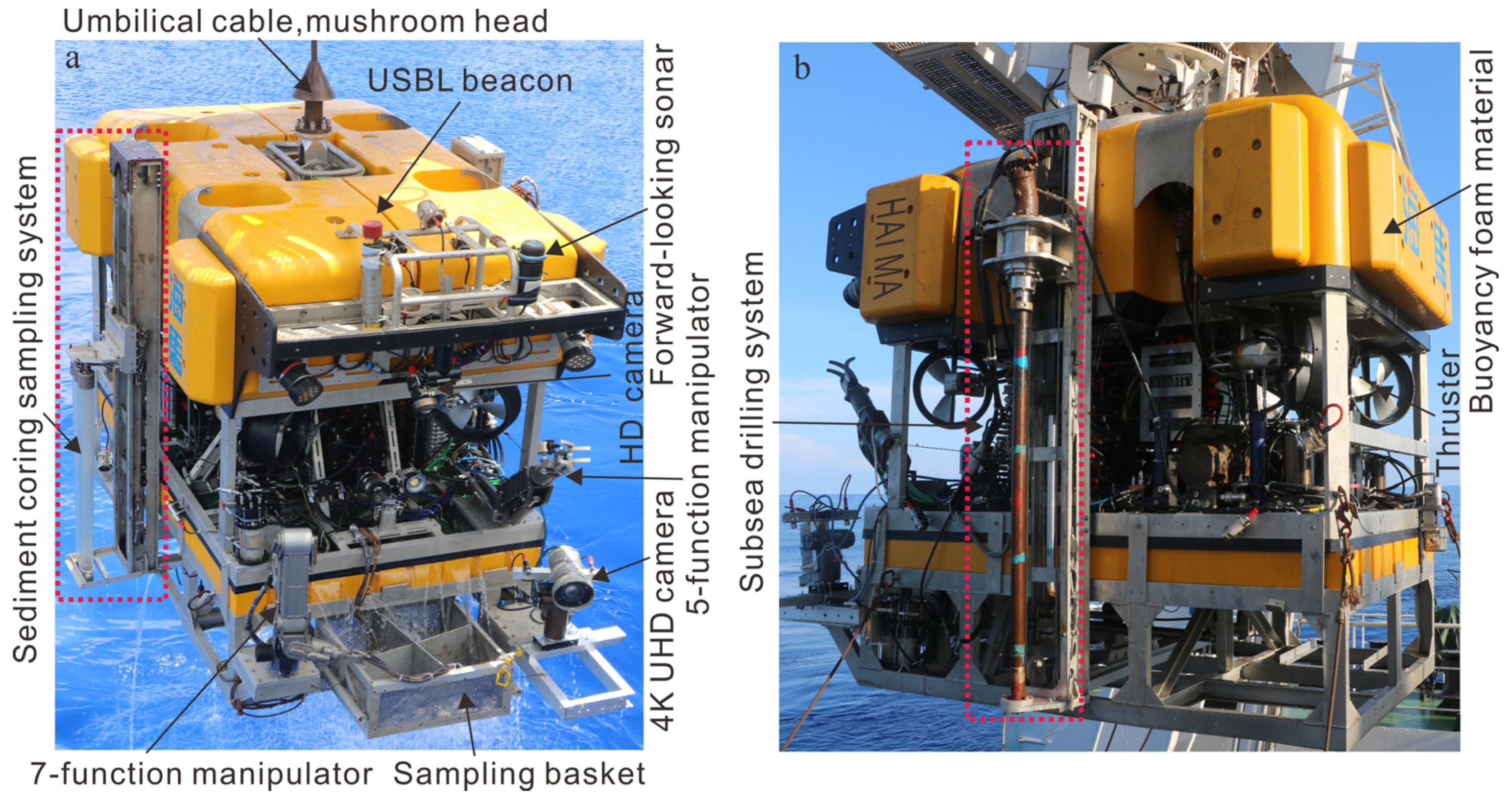
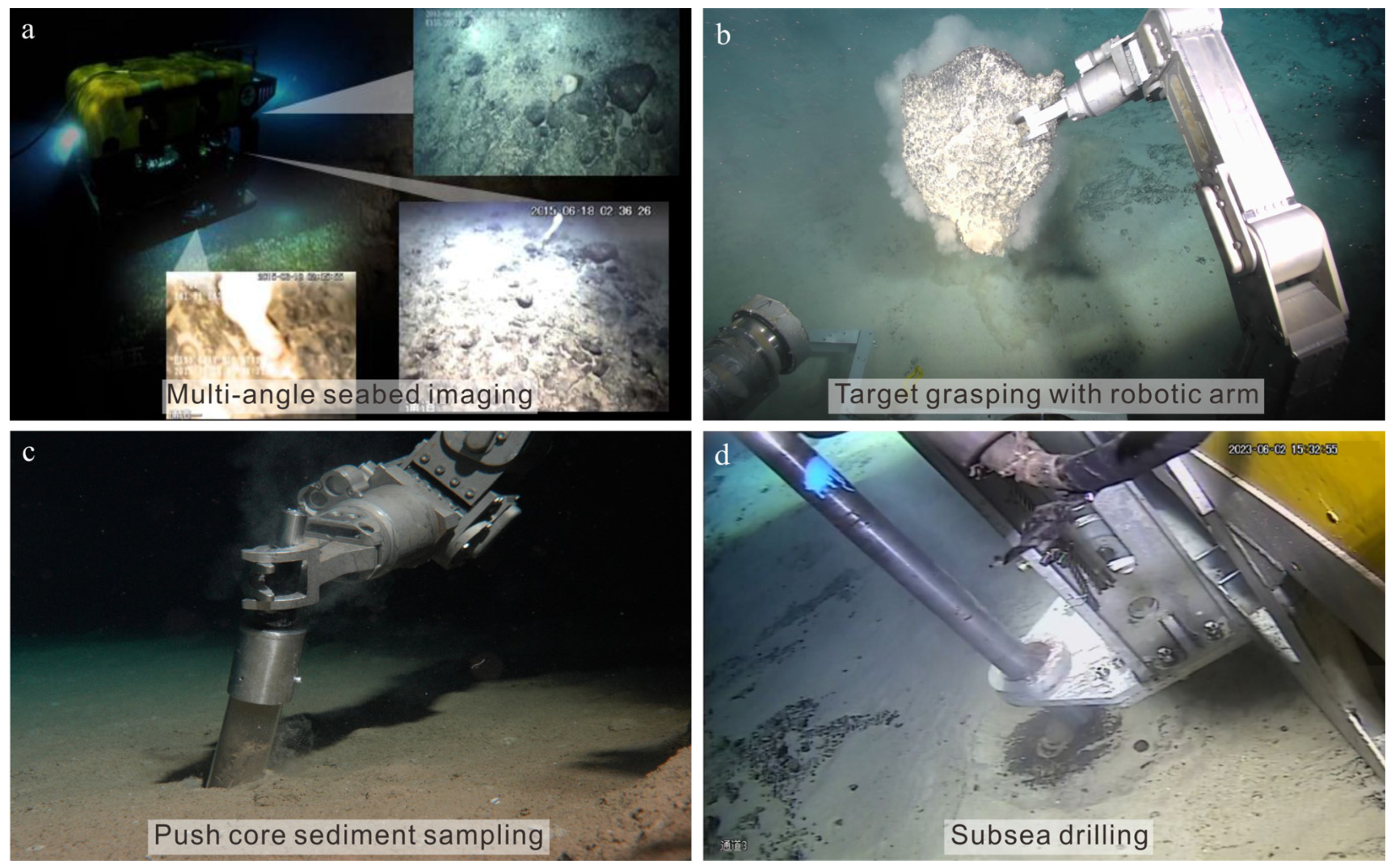

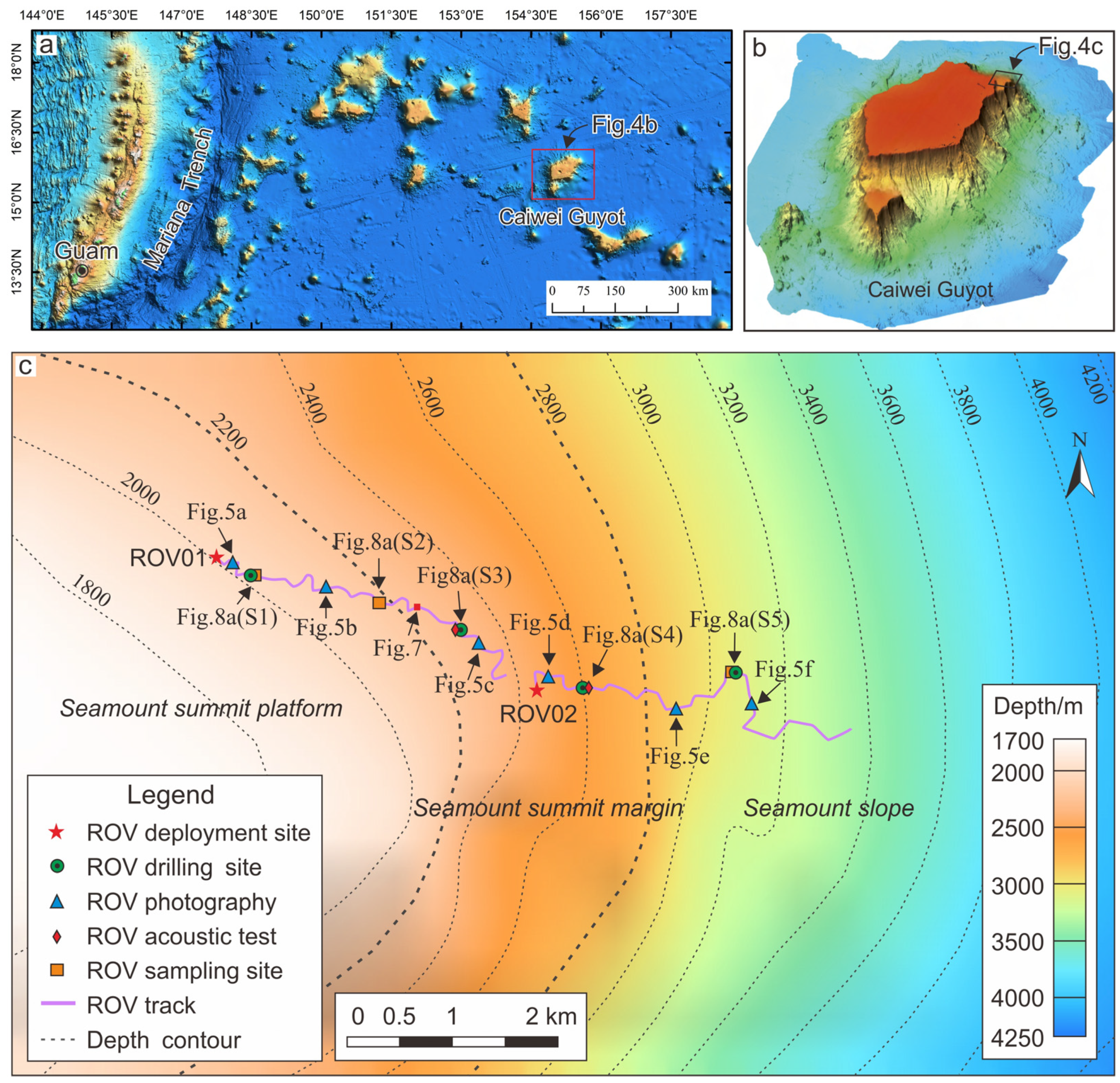
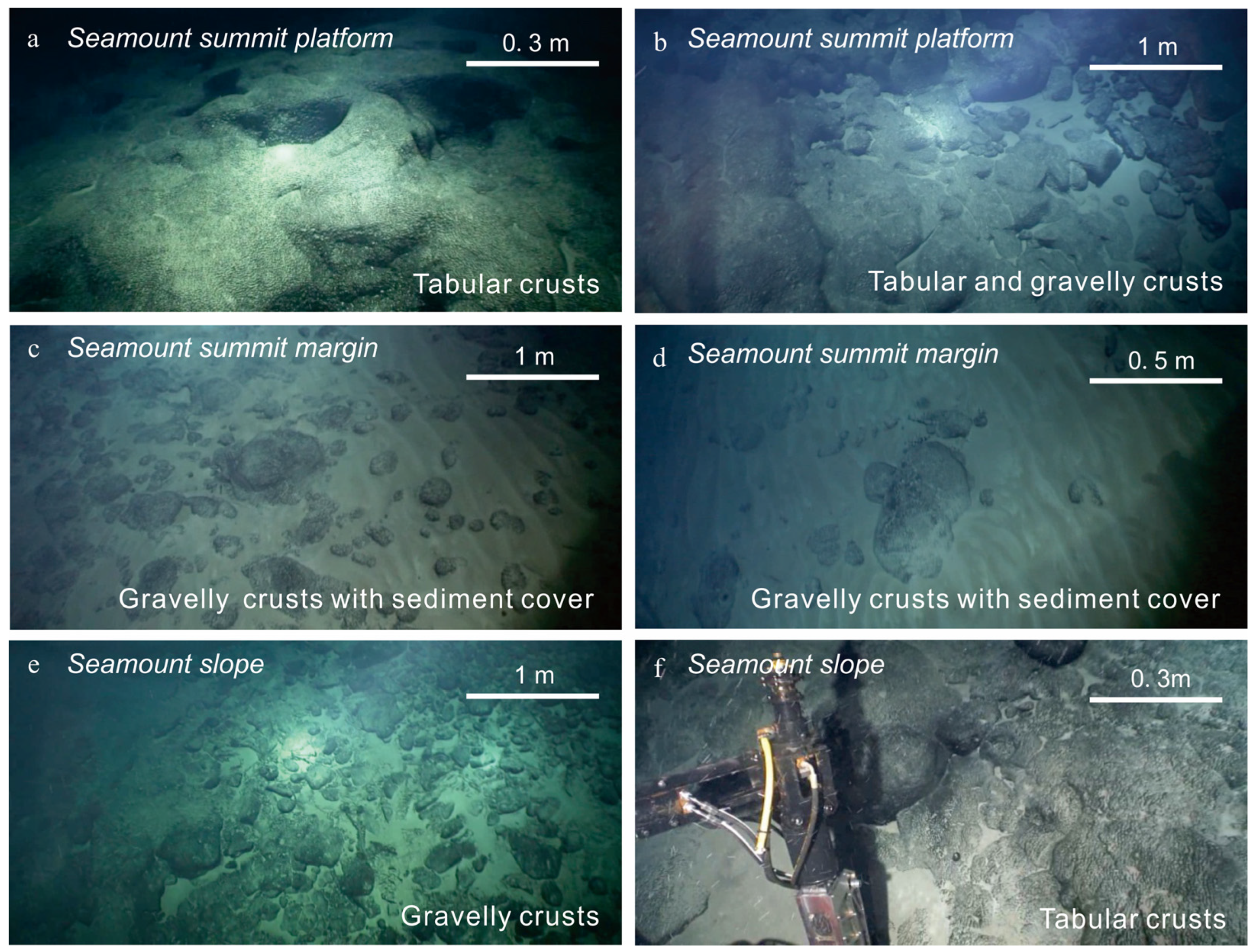
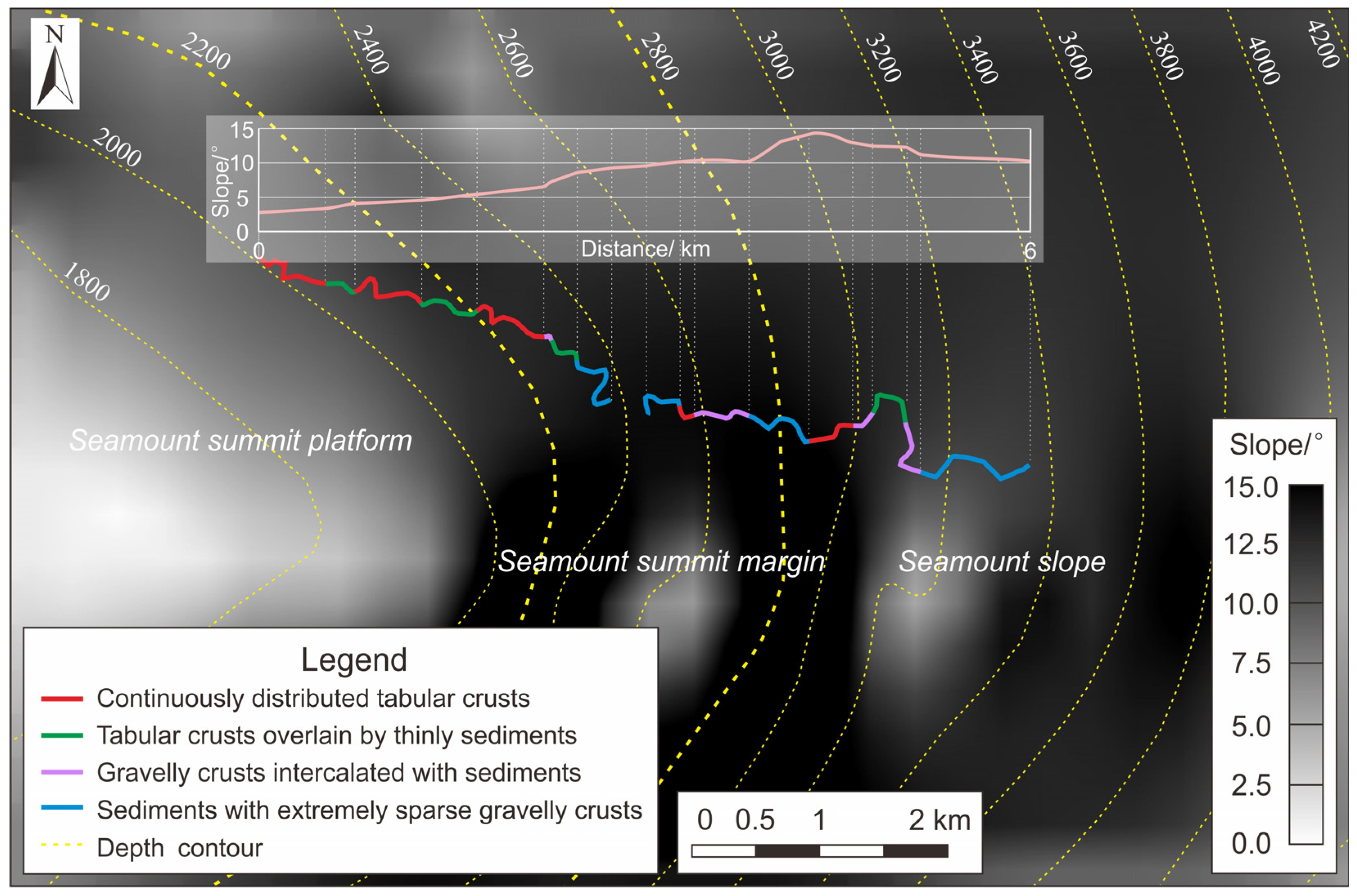
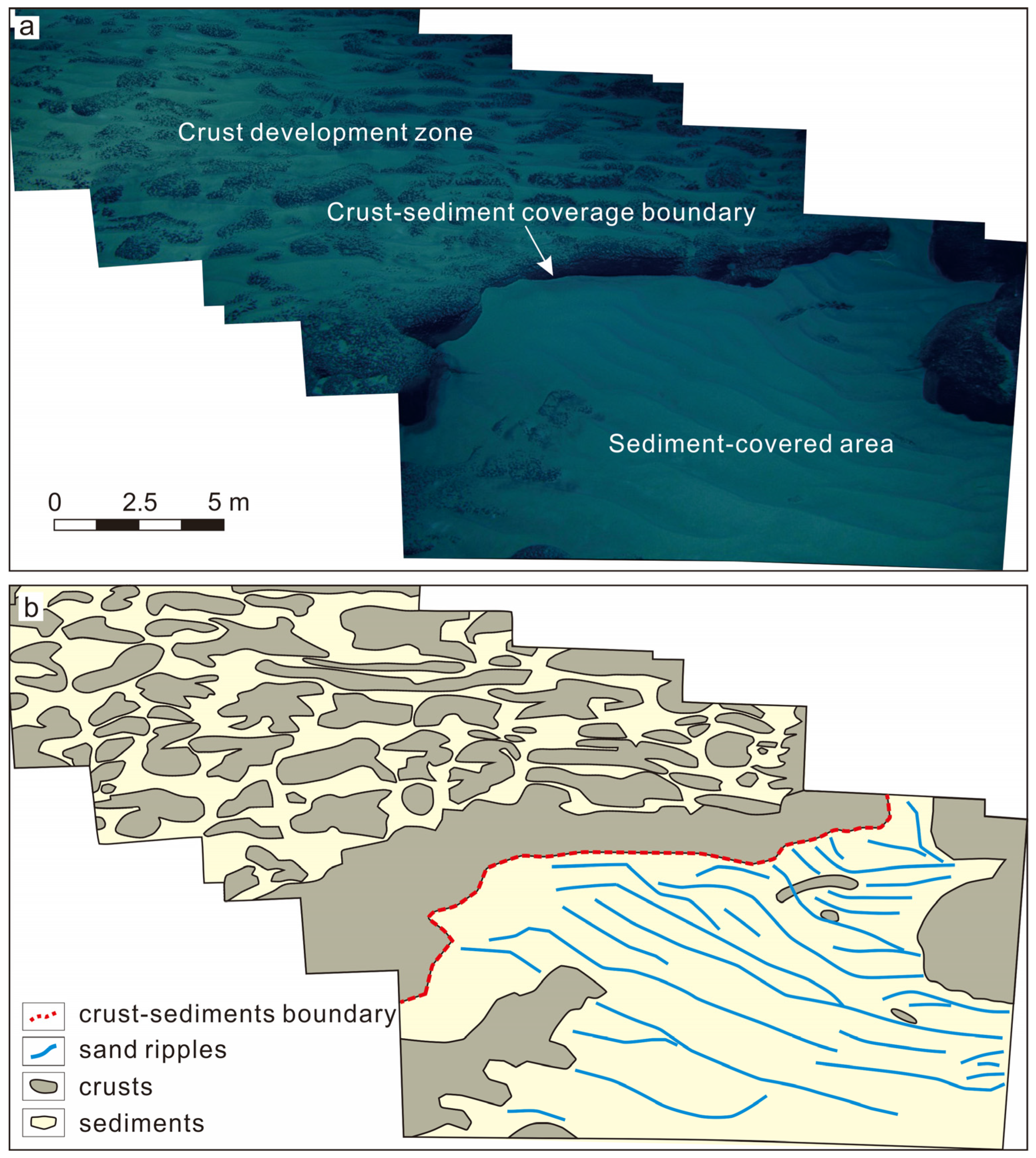
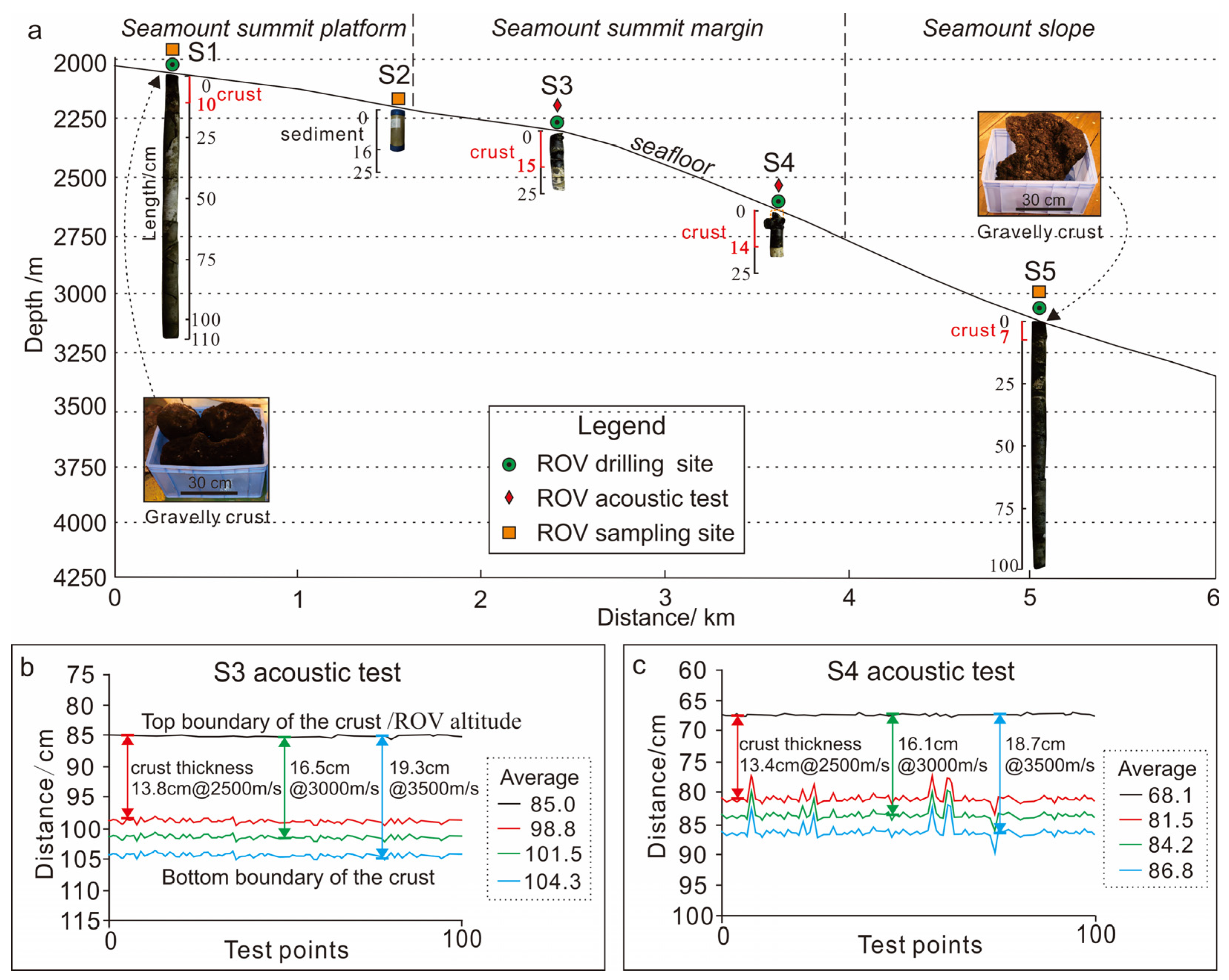
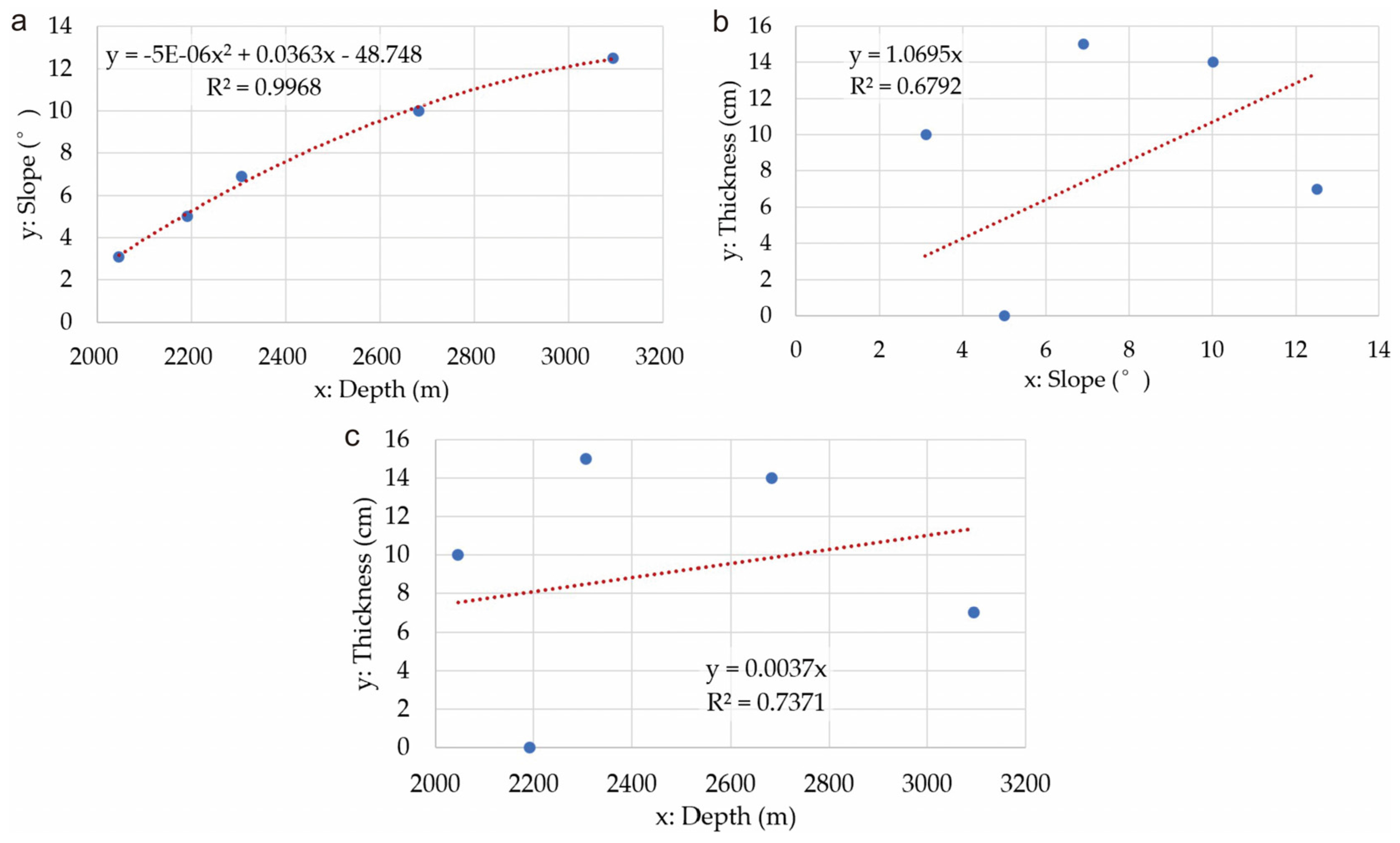
| Category | Specifications and Performance |
|---|---|
| Dimensions, Weight, Power |
|
| Underwater Lighting |
|
| Auxiliary Sensors |
|
| Underwater Cameras |
|
| Manipulation System and Chassis |
|
| Drilling System |
|
| Acoustic Detection System | Acoustic crust thickness gauge (1 set): Nonlinear parametric array (primary frequency: 1 MHz, difference frequency: 100 kHz) |
| Site | Crust Thickness (cm) | Acoustic Crust Thickness (cm) | Min. RE | Slope (°) | Depth (m) | ||
|---|---|---|---|---|---|---|---|
| Velocity: 2500 m/s | Velocity: 3000 m/s | Velocity: 3500 m/s | |||||
| S1 | 10.0 | / | / | / | / | 3.1 | 2046.3 |
| S2 | 0 | / | / | / | / | 5.0 | 2192.1 |
| S3 | 15.0 | 13.8 | 16.5 | 19.3 | 8.0% | 6.9 | 2307.0 |
| S4 | 14.0 | 13.4 | 16.1 | 18.7 | 4.3% | 10.0 | 2682.8 |
| S5 | 7.0 | / | / | / | / | 12.5 | 3095.0 |
| Platform | Operational Mode | Advantages | Limitations |
|---|---|---|---|
| ROV | Tethered, free navigation, bottom landing | Extended operational duration (>12 h), high power capacity, superior modular expandability, high maneuverability in localized areas, real-time data transmission; capable of deploying heavy drilling rigs | High dependency on support vessels, limited operational depth range, constrained survey coverage (expanded via vessel mobility) |
| HOV | Untethered, free navigation, bottom landing | Exceptional maneuverability, full ocean depth capability, real-time human-in-the-loop control | Limited mission duration (8–12 h), restricted survey coverage, elevated personnel safety risks, insufficient power capacity for heavy drilling equipment |
| AUV | Untethered, autonomous navigation | High maneuverability, operational stability, support for swarm collaboration, low dependency on support vessels | Short mission duration (hours to days), frequent recovery requirements, delayed data retrieval; limited to acoustic/optical/chemical sensors, incapable of heavy equipment deployment |
| DTS | Tethered, towed navigation | Most extended operational duration, real-time data transmission, centimeter-level positioning accuracy | Poor maneuverability (large turning radius), sensitivity to platform dynamics; restricted to acoustic/optical/chemical sensors, incapable of heavy equipment deployment |
Disclaimer/Publisher’s Note: The statements, opinions and data contained in all publications are solely those of the individual author(s) and contributor(s) and not of MDPI and/or the editor(s). MDPI and/or the editor(s) disclaim responsibility for any injury to people or property resulting from any ideas, methods, instructions or products referred to in the content. |
© 2025 by the authors. Licensee MDPI, Basel, Switzerland. This article is an open access article distributed under the terms and conditions of the Creative Commons Attribution (CC BY) license (https://creativecommons.org/licenses/by/4.0/).
Share and Cite
Li, Y.; Yao, H.; Chen, Z.; Wang, L.; Zhou, H.; Zhang, S.; Zhao, B. Detailed Investigation of Cobalt-Rich Crusts in Complex Seamount Terrains Using the Haima ROV: Integrating Optical Imaging, Sampling, and Acoustic Methods. J. Mar. Sci. Eng. 2025, 13, 702. https://doi.org/10.3390/jmse13040702
Li Y, Yao H, Chen Z, Wang L, Zhou H, Zhang S, Zhao B. Detailed Investigation of Cobalt-Rich Crusts in Complex Seamount Terrains Using the Haima ROV: Integrating Optical Imaging, Sampling, and Acoustic Methods. Journal of Marine Science and Engineering. 2025; 13(4):702. https://doi.org/10.3390/jmse13040702
Chicago/Turabian StyleLi, Yonghang, Huiqiang Yao, Zongheng Chen, Lixing Wang, Haoyi Zhou, Shi Zhang, and Bin Zhao. 2025. "Detailed Investigation of Cobalt-Rich Crusts in Complex Seamount Terrains Using the Haima ROV: Integrating Optical Imaging, Sampling, and Acoustic Methods" Journal of Marine Science and Engineering 13, no. 4: 702. https://doi.org/10.3390/jmse13040702
APA StyleLi, Y., Yao, H., Chen, Z., Wang, L., Zhou, H., Zhang, S., & Zhao, B. (2025). Detailed Investigation of Cobalt-Rich Crusts in Complex Seamount Terrains Using the Haima ROV: Integrating Optical Imaging, Sampling, and Acoustic Methods. Journal of Marine Science and Engineering, 13(4), 702. https://doi.org/10.3390/jmse13040702






